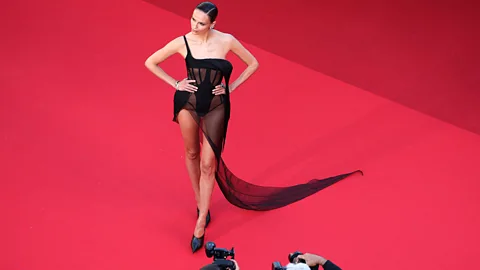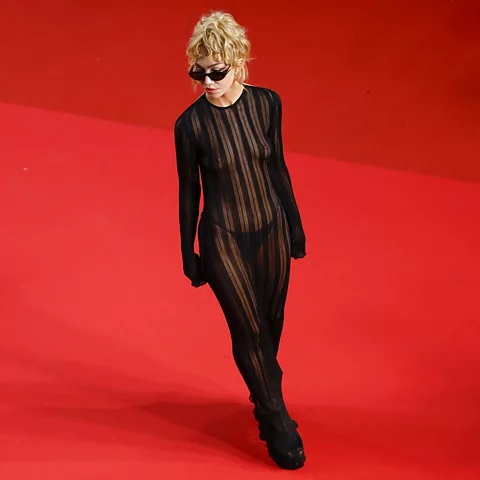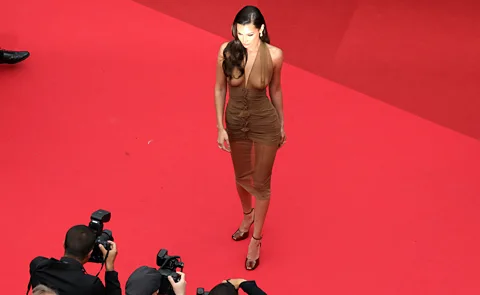The meaning behind Cannes' 'naked dress' red-carpet ban
 Getty Images
Getty ImagesThere's complex etiquette and a rich history behind the French film festival's red-carpet ban of "naked" or "voluminous" dressing. We decipher the "decency" dress code of the Cannes Film Festival in 2025.
That most rigid of red carpets just got a little bit more rigid – on Tuesday, the Cannes Film Festival announced that: "for decency reasons, nudity is prohibited on the red carpet, as well as in any other area of the festival."
It feels striking because naked dresses have become such a red-carpet staple in recent years, including at Cannes. Last year, for instance, the supermodel Bella Hadid wore a 10-denier Saint Laurent halter neck dress, while over the years stars from Isabelle Huppert, Naomi Campbell and Kendal Jenner have all opted for the oxymoronic trend.
 Getty Images
Getty ImagesLanding at a time when there is a rise in cultural conservatism, it feels in keeping with an uptick in the policing of women's bodies – in this instance, in the name of "decency". "God forbid someone serves a nipple," wrote Boring Not Com, an anonymous account famous in fashion circles, on Instagram – continuing, "the quiet return of conservatism is real".
For some, including Rose McGowan, so-called naked dressing is about empowerment.
And many observers also pointed out glaring double standards. "Bare skin is banned on the carpet, yet once inside, it's right there on the screen. Almost always female, of course," wrote Boring Not Com. "Let's not forget, this is the same festival that turned women away for wearing flats in 2015. All while still rolling out the red carpet for Roman Polanski [who in 1978 fled the US ahead of sentencing for the rape of a minor]."
Other commentators made the wider point that Cannes is home to another famous – paradoxical – rule defining what women wear: the 2016 burkini ban, which decreed that Muslim women wearing burkinis could be a threat to public order. "A woman dressing modestly and covering her head for religious reasons is not allowed and a woman in a sheer dress is also seen as 'indecent'. You need to dress conservatively but not too conservatively. It’s a lose-lose situation," wrote Shahed Ezaydi in Stylist.
 Getty Images
Getty ImagesBut the festival ban does not stop at nudity, also decreeing that "voluminous outfits, in particular those with a large train, that hinder the proper flow of traffic of guests and complicate seating in the theatre are not permitted". It strikes at the heart of the question: what is the red carpet actually for?
What – or rather who – people are wearing has been an essential question ever since Joan Rivers first framed it as such on the Golden Globes red carpet in 1994. In more recent years, red carpets have been likened to enormous adverts; marketing exercises where celebrities get paid big money to wear a certain designer's work, arguably shifting the focus from the films to the fashion. In many cases – the Met Gala being the most extreme example – they have become a platform for increasingly dramatic sartorial spectacles intended to garner as much attention as possible; big trains, it turns out, do exactly that. Whether that is a good or bad thing is subjective.
But Cannes has arguably remained a little different. According to one fashion insider, quoted in the Guardian in 2023, "the main US awards are more heavily financially backed – with fees of $100k+ [£75.4k+] for a red carpet look – so there is so much more pressure". In contrast, "at Cannes, there is less obligation [to wear certain brands and certain things]".
Although Cannes is to thank for some of the sartorial freedom, this is perhaps part of the problem, too. The French festival has become an unofficial fashion week. For many, the blockbusting fashion is now almost as noteworthy as the films themselves. For a festival that takes its film very seriously, this must gall.
But for others, who perhaps hold a more generous view of the artistry of fashion, that isn't the most salient point. Given the announcement about the banning was made just a day before the festival, when outfits will have been being planned for months, some commentators spared a thought for fashion industry workers. "Thoughts and prayers to all the stylists," wrote style writer Louis Pisano on Instagram. "It is a low blow," said Besovic. "It shows how much you don't respect the people who are attending your festival… especially the stylists… You couldn’t have done this two months ago?" Halle Berry, herself a fan of a naked dress on the red carpet, has already fallen foul – she reportedly had a voluminous dress planned that she now "can't wear because the train is too big". However, the US star added: "I had to make a pivot. But the nudity part I do think is probably also a good rule."
 Getty Images
Getty ImagesFor some, though, the side of the ban dealing with volume makes more sense than the nudity. As Cannes veteran Pisano described, speaking to Vogue Business, in recent years the carpet has been overwhelmed with influencers intentionally wearing the "craziest, most insane, biggest thing they can find… They take up the most space on the red carpet and," with thousands of people needing to get into the cinemas, "everybody gets clogged up". This is not the first time the Cannes Film Festival has implemented a ban designed to speed things up. In 2018, the festival’s artistic director, Thierry Frémaux, banned the selfie, telling Le Film Français magazine that, "on the red carpet, the trivial aspect and the slowing down provoked by the disorder which these selfies create tarnishes the quality of [the red-carpet experience] and of the festival as a whole".
So will Cannes really police this ban? While the festival has outlined that "welcoming teams will be obligated to prohibit red-carpet access to anyone not respecting these rules," it remains to be seen how evenly that will be enforced. Because, despite setting such strict guidelines in the past, it hasn’t always been democratically good at applying them. In 1953, Pablo Picasso obtained special dispensation to wear a sheepskin coat in violation of the evening dress code. A journalist the same year was given no such privilege. On another occasion, no such allowances were made for Henry Miller, who, in 1960, refused to obey the code and, despite being a member of the jury, was turned away from the opening evening because he wasn’t wearing a dinner jacket.
The fact that all of this information is courtesy of the Cannes Festival website hints that there is at least some pride in creating a fuss via a dress code that they know full well a few will choose – and fewer will be allowed – to flaunt.
 Getty Images
Getty Images"Rumour has it," according to Style Not Come, that "it won't apply to the real stars of the carpet. The models and brand ambassadors who show up for the photo op, skip the screening and slip out the back. Which, let's be honest, is most of them." More likely is that a few influencers, wearing dresses the size of Citroën cars, will be shown the red carpet off-ramp.
If history tells us anything, those who do disobey and get away with it will be judged kindly in the public eye. Because disobeying a dress code considered to be draconian, snobbish or patriarchal has in the past amassed kudos for Hollywood stars who, in that moment, signal their approachability. Take Julia Roberts, who went barefoot in 2016, a year after flat shoes were disallowed. The move won her the title of "America's sweetheart" in Vanity Fair. Then in 2018 Kristen Stewart kicked off her Louboutins on the red carpet, having previously said to the Hollywood Reporter: "If you're not asking guys to wear heels and a dress, you cannot ask me either." Will those freeing the nipple – and getting away with it – receive similar praise?
--
If you liked this story sign up for The Essential List newsletter, a handpicked selection of features, videos and can't-miss news, delivered to your inbox twice a week.
